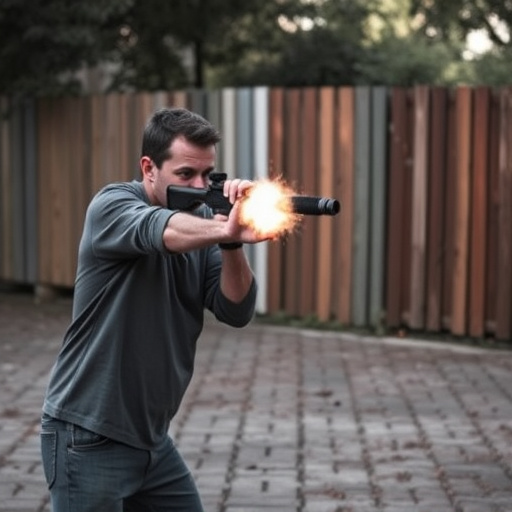Stun guns' effectiveness relies on neuromuscular disruption caused by high-voltage, low-current electrical shocks, temporarily paralyzing or disorienting targets. Safety switches prevent accidental discharges, ensuring user and public safety. Training and regular maintenance are crucial for responsible usage, as these devices disrupt muscle control through electric current.
“Uncover the essential safety feature of stun guns: the activation safety switch. This article explores the critical role of these switches in protecting users while highlighting the neuromuscular disruption caused by stun devices. We delve into the mechanisms behind stun gun functionality, explaining how they interrupt muscle function through the application of electric current. Additionally, best practices for safe activation and handling are provided to ensure user safety and responsible use.”
- Understanding Neuromuscular Disruption in Stun Devices
- Safety Switches: A Critical Component for User Protection
- Mechanisms of Action: How Stun Guns Interrupt Muscle Function
- Best Practices for Safe Stun Gun Activation and Handling
Understanding Neuromuscular Disruption in Stun Devices

The effectiveness of stun guns relies heavily on understanding neuromuscular disruption, a key mechanism in their operation. Stun devices work by delivering an electric current that overrides the body’s natural electrical signals, causing muscles to contract involuntarily and leading to temporary paralysis or disorientation in the target. This neuromuscular disruption is achieved through specialized circuitry and high-voltage discharge, ensuring rapid and efficient immobilization.
The neuromuscular effects of stun devices are designed to be non-lethal but powerful enough to subdue an assailant. By disrupting the communication between the central nervous system and muscles, these devices prevent the body from coordinating movements, resulting in a loss of balance and control. This disruption is temporary, allowing for safe de-escalation and intervention while ensuring the safety of both the user and the targeted individual.
Safety Switches: A Critical Component for User Protection

Safety switches play a pivotal role in ensuring the secure and controlled activation of stun guns, safeguarding both users and those around them from accidental or unintended discharges. These switches are designed to mitigate the neuromuscular effects of stun devices by implementing a simple yet effective mechanism to deactivate the device promptly.
By requiring an intentional action, such as a firm press or twist, to activate the stun gun, safety switches prevent accidental activation that could occur due to jostling, impact, or unintended contact. This feature is particularly crucial given the potent neuromuscular effects of stun devices, which temporarily disrupt muscle control and balance, potentially leading to serious injury or even death if not used responsibly.
Mechanisms of Action: How Stun Guns Interrupt Muscle Function

Stun guns, also known as electronic control devices (ECDs), work by delivering a high-voltage, low-current electrical shock to disrupt muscle function. This interruption is achieved through a process that targets the neuromuscular system. When activated, the stun gun generates an electric current that flows from the device’s electrodes through the body, affecting the communication between the nervous system and muscles.
The neuromuscular effects of stun devices are significant. The electrical impulse interferes with the nerve signals responsible for controlling muscle contraction, leading to temporary paralysis. This disruption prevents the muscles from receiving the necessary signals to contract, effectively immobilizing the target individual. The shock also causes pain, which acts as a warning signal to potential threats and helps in de-escalating dangerous situations.
Best Practices for Safe Stun Gun Activation and Handling

When activating a stun gun, it’s paramount to prioritize safety to mitigate the risk associated with its neuromuscular effects. Always ensure your finger is not on the trigger until you’re ready to deploy the device. A quick double-check of the environment before activation can prevent accidental discharge, especially in close quarters or around children and pets. Remember, stun guns use electric current to disrupt muscle control, so proper handling is crucial.
Training is essential for familiarizing yourself with the stun gun’s unique features and ensuring you understand its limitations. Keep your device clean and well-maintained to guarantee optimal performance when needed. Storing it in a secure, accessible location helps ensure quick retrieval during an emergency. Regularly review safety protocols and be prepared to react swiftly but responsibly whenever using a stun gun.
The neuromuscular disruption caused by stun devices, or electroshock weapons, highlights the importance of safety switches as critical components in user protection. By understanding how these devices interrupt muscle function through the neuromuscular effects known as the “nerve impulse block” and “muscle contraction,” we can emphasize best practices for safe activation and handling. Implementing proper precautions, such as ensuring a clear path to target areas and maintaining awareness of surrounding environments, is essential when employing stun guns. These safety measures contribute to responsible use, minimizing potential risks while leveraging the power of neuromuscular disruption for personal protection.
